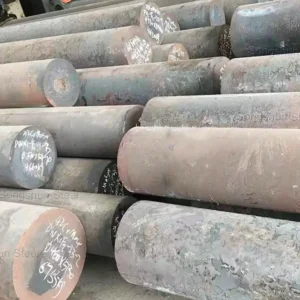Description
16MnCr5 Alloy Steel: Detailed Overview
16MnCr5 is a high-quality low-alloy steel known for its excellent hardness, strength, and wear resistance, making it ideal for a range of industrial applications. This alloy is frequently used in the manufacturing of gears, shafts, and other high-stress components that require superior mechanical properties.
Introduction to 16MnCr5 Alloy Steel
16MnCr5 is a medium carbon, low-alloy steel that combines manganese, chromium, and carbon to achieve a balance of strength, toughness, and wear resistance. It is commonly used in applications where high mechanical performance and durability are essential.
Key Features of 16MnCr5 Alloy Steel:
- Good Hardness: Capable of achieving high hardness through heat treatment.
- Strength: High tensile strength suitable for heavy-duty applications.
- Wear Resistance: Excellent resistance to wear and abrasion.
- Toughness: Good impact resistance and toughness.
Applications of 16MnCr5 Alloy Steel
16MnCr5 is used in various industries for components that demand high strength and durability. Its properties make it suitable for parts that are subject to significant mechanical stress and wear.
Typical Applications Include:
- Automotive Industry: Gears, shafts, and camshafts.
- Engineering Components: Crankshafts, pinions, and couplings.
- Industrial Machinery: High-load bearings and drive shafts.
- Manufacturing Equipment: Machine parts and tool components.
Equivalent Grades of 16MnCr5 Alloy Steel
16MnCr5 is recognized under different standards, ensuring compatibility across various regions and industries.
| Standard | Equivalent Grade |
|---|---|
| DIN | 1.7131 |
| EN | 16MnCr5 |
| AISI/SAE | 5115 |
| BS | 8650 |
Chemical Composition of 16MnCr5 Alloy Steel
The chemical composition of 16MnCr5 is designed to provide the right balance of hardness, strength, and wear resistance. The typical composition is as follows:
| Element | Composition (%) |
|---|---|
| Carbon (C) | 0.14 – 0.19 |
| Silicon (Si) | 0.40 max |
| Manganese (Mn) | 1.10 – 1.40 |
| Phosphorus (P) | 0.035 max |
| Sulfur (S) | 0.035 max |
| Chromium (Cr) | 0.80 – 1.10 |
This composition ensures that the steel achieves high hardness and strength while maintaining good toughness.
Mechanical Properties of 16MnCr5 Alloy Steel
The mechanical properties of 16MnCr5 are critical for evaluating its performance in demanding applications. The following table summarizes these properties:
| Property | Value (Typical) |
|---|---|
| Tensile Strength (MPa) | 650 – 850 |
| Yield Strength (MPa) | 450 – 600 |
| Elongation (%) | ≥ 15 |
| Impact Toughness (J) | ≥ 35 (at room temperature) |
| Hardness (HB) | 207 – 255 |
These values indicate the steel’s ability to withstand high stresses and impacts.
Heat Treatment of 16MnCr5 Alloy Steel
Heat treatment processes are essential for achieving the desired mechanical properties in 16MnCr5. The following processes are commonly used:
- Hardening: Heat to 850 – 880°C and quench in oil or water to increase hardness.
- Tempering: Heat to 150 – 200°C after hardening to reduce brittleness and improve toughness.
- Normalizing: Heat to 850 – 880°C and air cool to refine grain structure and improve toughness.
These treatments help to tailor the steel’s properties for specific applications.
Hardness of 16MnCr5 Alloy Steel
The hardness of 16MnCr5 can be adjusted through heat treatment processes. Typical hardness values are:
- Annealed Condition: 170 – 207 HB
- After Hardening and Tempering: Up to 56 HRC
These hardness values reflect the steel’s capability to resist wear and deformation under load.
Physical Properties of 16MnCr5 Alloy Steel
The physical properties of 16MnCr5 contribute to its performance and reliability. The following table summarizes these properties:
| Property | Value |
|---|---|
| Density (g/cm³) | 7.85 |
| Melting Point (°C) | 1420 – 1460 |
| Thermal Conductivity (W/m·K) | 40 – 45 |
| Specific Heat Capacity (J/kg·K) | 460 – 480 |
These properties ensure stability and performance in various operating conditions.
Forging Properties of 16MnCr5 Alloy Steel
16MnCr5 can be forged at temperatures ranging from 1150 – 1250°C. It is important to cool the forged components slowly to prevent internal stresses and maintain dimensional stability.
Stress Relieving for 16MnCr5 Alloy Steel
Stress relieving involves heating the steel to 600 – 650°C to remove residual stresses from machining or forming. This process helps improve dimensional stability and reduce the risk of deformation.
Normalizing 16MnCr5 Alloy Steel
Normalizing is performed by heating the steel to 850 – 880°C and allowing it to cool in air. This process enhances toughness and refines the grain structure.
Annealing 16MnCr5 Alloy Steel
Annealing involves heating the steel to 680 – 720°C and cooling it slowly in the furnace. This process improves machinability and prepares the steel for further heat treatments.
Machinability of 16MnCr5 Alloy Steel
16MnCr5 alloy steel exhibits good machinability, especially in its annealed condition. It can be machined into complex shapes with standard cutting tools, although care should be taken to manage tool wear during high-hardness operations.
Welding of 16MnCr5 Alloy Steel
Welding of 16MnCr5 is feasible with proper preheating (to about 150 – 200°C) and post-weld heat treatment. Following appropriate welding procedures helps prevent issues such as cracking or reduced toughness.
Supply Cities:
Mumbai Ahmedabad, Amaravathi, Ambattur, Bangalore, Belgaum, Chennai, Chittoor, Coimbatore, Dindigul, Mysore, Nellore, Hyderabad, Kochi, Mangalore, Tirupur, Tuticorin, Madurai, Andhra Pradesh, Karnataka, Puducherry, Kerala, Tamil Nadu, Telangana, Visakhapatnam, Kochi, Kerala, Hubli-Dharwad, Karnataka, Ghaziabad Kolkata.






